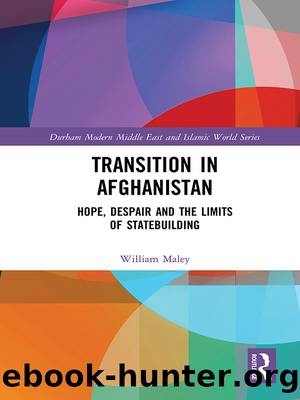Transition in Afghanistan by William Maley

Author:William Maley [Maley, William]
Language: eng
Format: epub
Tags: Social Science, Regional Studies
ISBN: 9781351389761
Google: 0SFWDwAAQBAJ
Publisher: Routledge
Published: 2018-04-17T04:08:15+00:00
Law in Afghanistan
In many parts of the world, it is broadly clear what makes up the body of a countryâs law, although questions may arise as to how the law should be interpreted or understood, and issues such as the continued role of established rules in indigenous or minority communities may need to be addressed. A great deal of legal theory has been directed at explaining what is distinctive about law, and what its sources might be. H.L.A. Hart, for example, depicted law as a union of primary and secondary rules grounded âin an ultimate rule of recognition providing authoritative criteria for the identification of valid rules of the systemâ,24 with the rule of recognition existing âonly as a complex, but normally concordant, practice of the court, officials, and private persons in identifying the law by reference to certain criteriaâ.25 Marmor has recently argued that rules of recognition in Hartâs sense, varying from jurisdiction to jurisdiction, are âsurface conventionsâ which instantiate âdeep conventionsâ of a systemic variety, such as common law or continental law.26 This usefully draws attention to the traditional dimension of law, which has been highlighted by scholars such as Martin Krygier.27
When we come to Afghanistan, however, we confront a decidedly confused situation in which it is far from clear that there is any single rule of recognition on which to rely, and in which arguably there is a longstanding tension, reflecting a multiplicity of deep conventions, between different kinds of rules that have carried weight in Afghan society. In May 1997, this writer visited a functioning court in the town of Balkh in northern Afghanistan which captured some of these confusions. On the one hand, the judge (qadi) was applying Hanafi Sunni jurisprudence to rule on a commercial dispute between two parties. On the other hand, as he openly admitted, his standing to do so arose from his having been appointed to the position by the then local âstrongmanâ or âwarlordâ, Abdul Rashid Dostam.28 He had no connection to any kind of âstateâ, and historical civil codes did not figure in his legal reasoning. And while Dostam certainly held power locally, it was not on the strength of his âIslamicâ credentials, which were extraordinarily thin, but on the basis of backing from Uzbek co-ethnics. While the parties in the case at hand were seemingly quite happy to accept the qadiâs rulings, any attempt to provide a simple account of the sources of his juridical authority could have proved quite daunting. Historically, law has had a range of different sources in Afghanistan, and the more recent experience of state disruption has only complicated the situation.
The longest-standing source of law in Afghanistan has certainly been Islamic law, or Shariâa, which is subtle and complex, with a venerable history.29 The predominant school in Afghanistan has been the Hanafi school, and it has been applied over a long period of time. Ashraf Ghani has documented the important roles of Shariâa courts in statebuilding in the late 19th century, through a process he described as the âbureaucratization of the qadiâ.
Download
This site does not store any files on its server. We only index and link to content provided by other sites. Please contact the content providers to delete copyright contents if any and email us, we'll remove relevant links or contents immediately.
| Central Asia | Southeast Asia |
| China | Hong Kong |
| India | Japan |
| Korea | Pakistan |
| Philippines | Russia |
The Rape of Nanking by Iris Chang(3520)
The Sympathizer by Viet Thanh Nguyen(3501)
World without end by Ken Follett(3009)
Ants Among Elephants by Sujatha Gidla(2927)
Blood and Sand by Alex Von Tunzelmann(2611)
Japanese Design by Patricia J. Graham(2560)
City of Djinns: a year in Delhi by William Dalrymple(2138)
Inglorious Empire by Shashi Tharoor(2103)
In Order to Live: A North Korean Girl's Journey to Freedom by Yeonmi Park(2059)
Foreign Devils on the Silk Road: The Search for the Lost Treasures of Central Asia by Peter Hopkirk(2058)
Tokyo by Rob Goss(2021)
India's biggest cover-up by Dhar Anuj(1988)
India's Ancient Past by R.S. Sharma(1988)
The Great Game: On Secret Service in High Asia by Peter Hopkirk(1962)
Tokyo Geek's Guide: Manga, Anime, Gaming, Cosplay, Toys, Idols & More - The Ultimate Guide to Japan's Otaku Culture by Simone Gianni(1949)
Goodbye Madame Butterfly(1938)
The Queen of Nothing by Holly Black(1758)
Living Silence in Burma by Christina Fink(1732)
Batik by Rudolf Smend(1723)
